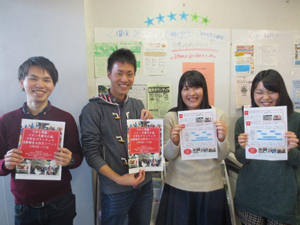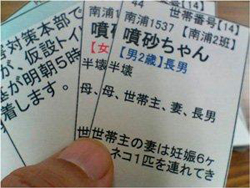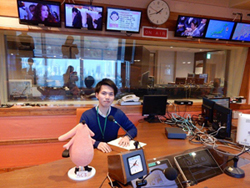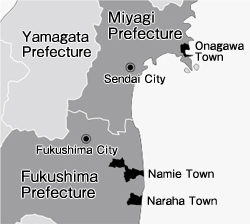Top>HAKUMON Chuo [2016 Spring Issue]>“Team Disaster-Preparedness” Toward Advanced Disaster Relief
 Index
Index
Close up

Members of Team Disaster-Preparedness hold leaflets on disaster-preparedness events. From left: Sato, Nakamura, Koyama, and Nishizawa.
“Team Disaster-Preparedness” Toward Advanced Disaster Relief
4 members of the Volunteer Center awarded by the Hino Council of Social Welfare
“Team Disaster-Preparedness” is composed of four students from the Chuo University Volunteer Center. On March 12, Team Disaster Preparedness received an award from the Hino Council of Social Welfare (a social welfare corporation) in recognition of their constant activities for increasing awareness toward disaster-preparedness. On February 6, team leader Hiroki Sato (4th-year student in the Faculty of Law) appeared on an NHK radio program.
Team Disaster-Preparedness was recognized by the local community around Chuo University and attracted the attention of the mass media. The team was suddenly thrust into the spotlight as society reflected on earthquakes, disaster-preparedness, and disaster-prevention in memory of the Great Hanshin-Awaji Earthquake (January 17) and the Great East Japan Earthquake (March 11).
4.0 earthquake only one minute before guest appearance
Natural disasters occur suddenly. One poignant example of this unpredictability occurred before Sato’s scheduled appearance on the NHK radio program Mai Asa Rajio (05:00 to 08:00 every morning).
One minute before Sato was scheduled to appear on the program, an earthquake with a magnitude of about 4.0 struck the southern Kanto region. The program abruptly changed to earthquake reports. The report on activities by Chuo students (7 minutes) was rescheduled to the following day.
“It was an unfortunate reminder that we never know when an earthquake will strike,” says Sato.
Sato and his friend Ryoji Nakamura (4th-year student in the Faculty of Commerce) learned disaster-response methods from instructors in a Disaster Relief Volunteer Course held by the Association for the Promotion of Disaster Prevention Volunteers (a private association).
The main themes included removal of rubble, relief activities, and communication with victims. Volunteers must deal with a variety of issues.
The material covered in the course was completely new to Sato and Nakamura. They deeply recognized the importance of disaster response, and decided to convey what they had learned to as many people as possible.
From receiving relief to providing relief

HUG cards list conditions of evacuees
The students devised a game which was set in a gymnasium being used as an evacuation shelter for disaster victims. In the game, players learned how relief workers and volunteers move within the shelter.
The game was named HUG, or Hinanjo Unei Geimu (Evacuation Shelter Operation Game). Players placed cards on a floor map of the shelter. Sato and Nakamura took their game to be played on campus.
The cards list information such as the health condition, residence, and family structure of evacuees. When players draw an “Event Card,” they are instructed to decide on a position for toilets and smoking areas. HUG envisions that game participants are managers of an evacuation shelter. In the game, players cooperate to decide on the stationing of evacuees and on response to randomly occurring events.
Should rest space for the elderly be positioned at the back of the shelter, away from the cold wind? Do disabled people have a visual or auditory disability? Players must carefully read information from the cards and take the optimal response.
Even the positioning of a single toilet requires great thought. Assume that a total of four toilets will be installed. Many people would decide on two toilets for men and two for women, but Sato disagrees. “Men are relatively quick when using the bathroom,” he says. “I have heard that long lines can form for women’s bathrooms.” Members discussed the issue and decided on one toilet for men and three for women. Their decision was well-received as being appropriate for actual conditions.
After participating in the game, Keiko Koyama (4th-year student in the Faculty of Policy Studies) and Shiori Nishizawa (4th-year student in the Faculty of Policy Studies) became new members and Team Disaster-Preparedness was formed. Koyama and Nishizawa also took the disaster-preparedness volunteer course introduced in the beginning of this article.
The four students visited residents’ association, elementary schools, junior high schools, and high schools in the community around Chuo University. In addition to assisting organizers, they conveyed the knowledge and information which they had obtained. They also implemented methods for responding to disasters.
The ideal process is for people receiving relief to transition into providing relief. The team hopes to increase the number of people who possess relief knowledge. A greater number of people with knowledge of evacuation will contribute to a higher survival rate.
Frustration in the community

Sato looks like a newscaster while appearing on an NHK radio program.
Sato was born in the Date District of Koori Town in Fukushima Prefecture. He experienced the Great East Japan Earthquake when he was in second grade of high school. His hometown is located inland and suffered relatively little damage due to the giant tsunami and accident at the Fukushima Daiichi Nuclear Power Station.
Even so, the gymnasium of his high school was used as an evacuation shelter. Every day on his way to and from school, Sato thought about the evacuees. “I felt really bad for people who wanted to return to their homes, but couldn’t,” recalls Sato.
On his Coming-of-Age Day, Sato attended a ceremony and was then interviewed by a local newsletter. He was asked for his opinion regarding the future of the disaster area. Sato answered that he wanted to “know correct information about current conditions.” However, he doubted his answer and felt frustrated that he couldn’t do more for the community.

Upon returning to university, Sato learned of the Volunteer Center-led Study Tour of Disaster Areas. The tour visited Onagawa Town in Miyagi Prefecture, an area which was devastated by the tsunami. He immediately decided to participate in the program and heard first-hand accounts of the disaster from residents of Onagawa.
In this way, Sato gradually became involved in volunteer activities. Eventually, he obtained certification as a Disaster Prevention Expert.
This system was created from experiences of the Great Hanshin-Awaji Earthquake and is operated by the Japan Bousaisi Organization (a specified nonprofit corporation). More than 100,000 people have been certified as Disaster Prevention Experts throughout Japan (as of January 2016). For two consecutive years in 2014 and 2015, the number of people acquiring certification has increased by the tens of thousands. This indicates increased awareness for disaster preparedness.
After graduation, Sato wants to work as a civil servant and contribute to reconstruction in disaster areas. In September of last year, evacuation orders which had been issued in conjunction with the nuclear accident were cleared for municipalities such as Naraha Town in Fukushima Prefecture. Although residents are starting to return to these municipalities, many people still feel uneasiness and impatience regarding whether or not these towns and villages will be able to function fully again. Even today, five years after the quake, more than 174,000 people are still forced to live in evacuation housing.
Sato will always remember the keyword of Kenya Miyazaki, a disaster-preparedness training consultant.
“If you always remember, you will always be prepared.”
We must never forget to take appropriate preparations. Disaster could strike as early as tomorrow—or even tonight.
Members of Team Disaster-Preparedness
- Keiko Koyama (4th-year student in the Faculty of Policy Studies)
- “I joined Team Disaster-Preparedness because I was interested in daily activities for disaster-preparedness in the community. While exchanging opinions on disaster preparedness with residents, I made new discoveries and learned new things. I reaffirmed the importance of increasing the awareness of each resident regarding disaster preparedness.”
- Shiori Nishizawa (4th-year student in the Faculty of Policy Studies)
- “When I participated in the HUG on campus, I was able to increase my interest and knowledge regarding disaster preparedness while enjoying the game. I wanted to give more people the same experience, so I decided to join Team Disaster-Preparedness. During activities, I had many opportunities to interact with local residents. This gave me many chances to learn more about disaster preparedness in the community.”
- Ryoji Nakamura (4th-year student in the Faculty of Commerce)
- “I learned the importance of preparing while envisioning the occurrence of disaster. Through activities, I learned the difficulty of operating an emergency shelter where people of different ages and health conditions gather. I also learned how to use a car jack in order to rescue people. I will use what I learned through these activities in the time of emergency.”
Further Information
Disaster Prevention Expert
According to the Japan Bousaisi Organization, Disaster Prevention Experts are able to minimize damage from disasters and lead disaster preparedness in the community. Experts are involved in operation of emergency shelters and volunteer relief activities in disaster areas. There are great expectations for the performance of Disaster Prevention Experts in cooperating with communities and municipalities in order to increase awareness for disaster preparedness.

Information from Chu-Oji
In October 2015, the Chuo University Volunteer Center started publishing the CVC Newsletter on A4 paper. The newsletter lists detailed information on activity reports for summer vacation (Summer Volunteers) and volunteer sites.
Team Disaster-Preparedness was introduced in Issue No. 2 (Spring Vacation Issue), which was published this January. The Chuo University volunteer mascot Chu-Oji answers questions about activities.
- Research Activities as a Member of Research Fellowship for Young Scientists (DC1), Japan Society for the Promotion of Science (JSPS) Shuma Tsurumi
- Important Factors for Innovation in Payment Services Nobuhiko Sugiura
- Beyond the Concepts of Fellow Citizens and Foreigners— To Achieve SDGs Goal 10 “Reduce Inequality Within and Among Countries” Rika Lee
- Diary of Struggles in Cambodia Fumie Fukuoka
- How Can We Measure Learning Ability?
—Analysis of a Competency Self-Assessment Questionnaire— Yu Saito / Yoko Neha - The Making of the Movie Kirakira Megane








